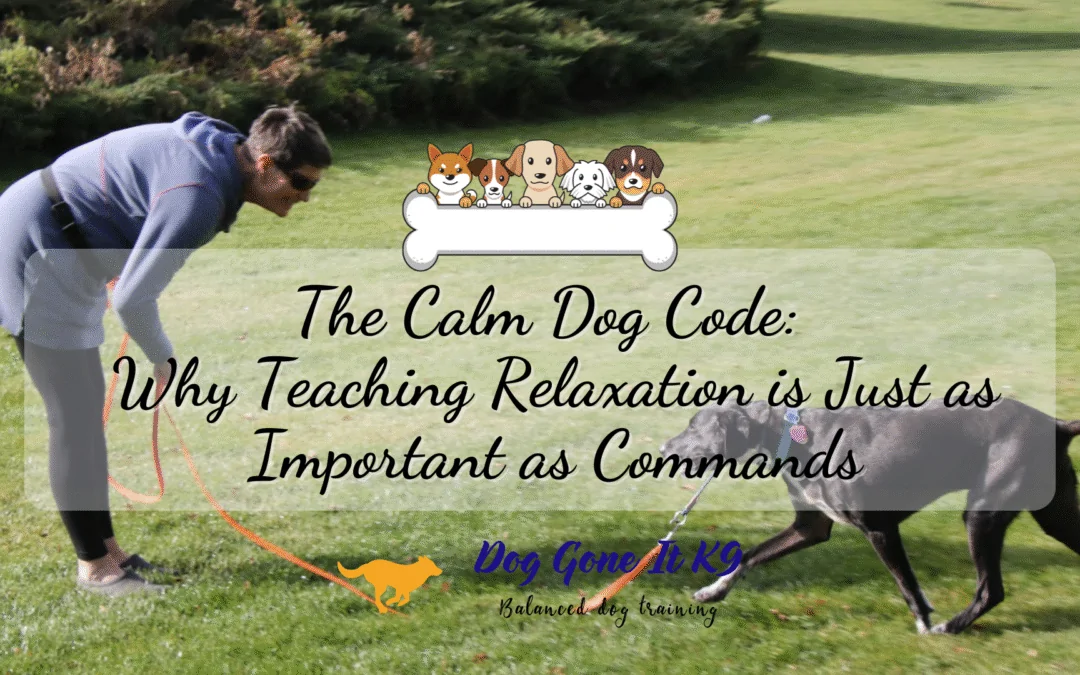Most dog owners focus on teaching cues like sit, stay, and come but here’s a little secret: your dog’s ability to relax is just as important as any obedience skill. A calm mind lays the foundation for good behavior, impulse control, and a happier dog overall. At Dog Gone It K9, we call this the Calm Dog Code – and mastering it can completely change your dog’s energy and your relationship with them.
Overstimulation and Behavior Issues
Why does my dog get overexcited so easily?
Modern dogs are surrounded by stimulation: doorbells, guests, other dogs, kids, and constant activity. When a dog never learns how to self-regulate, this overstimulation can lead to jumping, barking, pulling, and even aggression.
Think of it like this: if your dog’s “on switch” is easy to find but their “off switch” is missing, it’s only a matter of time before stress takes over. Over time, this chronic excitement makes it harder for your dog to focus, listen, or respond to cues.
Calm training helps your dog understand that not every sound or movement requires a reaction. Teaching your dog how to relax on cue gives them emotional balance, something many behavior problems stem from lacking.
Teaching “Place” and “Settle” Commands
How do I teach my dog to settle on command?
The “place” and “settle” commands are two of the most valuable tools for calm dog training.
- Place Command: This teaches your dog to go to a specific mat, bed, or spot and stay there calmly until released. It’s not a punishment—it’s a way to show your dog that relaxation is a choice.
- Settle Command: This reinforces calm body language wherever you are, helping your dog learn that lying quietly brings comfort and reward.
Start small: use treats to guide your dog onto their mat, mark with “yes” or “good,” and reward when they stay relaxed. Gradually extend the duration and add distractions. Over time, your dog will naturally begin to choose calmness, even in stimulating environments.
Calm vs. Excited Praise
Should I praise my dog when they’re calm?
Yes, but the way you praise matters. Dogs feed off your energy. High-pitched, excited praise might be great for playtime, but when you’re reinforcing calmness, your tone should match the behavior you want.
Use soft, steady praise when your dog is lying down or relaxing. A quiet “good settle” or gentle petting communicates peace far more effectively than an enthusiastic cheer.
If you want calm behavior, you have to reward calm energy. Excitement breeds excitement, so your energy sets the tone for your dog’s.
Creating Downtime Routines
How can I help my dog relax at home?
Dogs thrive on structure. Just like humans, they need time to rest and decompress. Building downtime into your dog’s daily routine teaches them that not every moment requires stimulation.
Try these relaxation habits:
- Scheduled rest periods: After walks or playtime, guide your dog to their “place” and practice calm reinforcement.
- Soothing environment: Use gentle background noise, dim lights, or a cozy bed to create a calm space.
- Consistent cues: Phrases like “settle down” or “take a break” help your dog understand when it’s time to shift from play to rest.
When relaxation becomes a daily habit, your dog’s overall behavior improves—because they’re no longer living in a constant state of arousal.
Practicing Calm Behavior in Public
How can I keep my dog calm in busy places?
Calmness shouldn’t stop at home. Practicing relaxation in public is essential for a well-rounded, confident dog.
Start small: bring your dog to quiet environments first, like a park bench or café patio and reward calm observation. Over time, gradually increase the level of distraction.
The goal isn’t to make your dog ignore the world, but to help them experience it without reacting. If your dog can lie calmly beside you at a coffee shop or wait quietly during a walk, that’s a huge win for impulse control.
Remember, calmness is a skill. It develops through repetition, patience, and consistency.
Why Calm Training Builds a Stronger Bond
When you teach your dog to relax, you’re not just managing behavior, you’re strengthening trust. Calmness invites connection. It helps your dog look to you for guidance instead of reacting on instinct.
By mastering impulse control, your dog learns to process the world more confidently. And when your dog can be calm in different situations, everyday life becomes easier, whether it’s greeting guests, passing another dog, or simply relaxing at home after a long day.
Ready to Teach Your Dog the Calm Dog Code?
If you’re tired of constant hyperactivity, leash pulling, or reactivity, calm dog training can help you create balance and peace in your home.
👉 Book a free discovery call with Dog Gone It K9 LLC to learn how our trainers can help you teach your dog to settle, build impulse control, and enjoy a calmer, happier life – one peaceful paw at a time.

